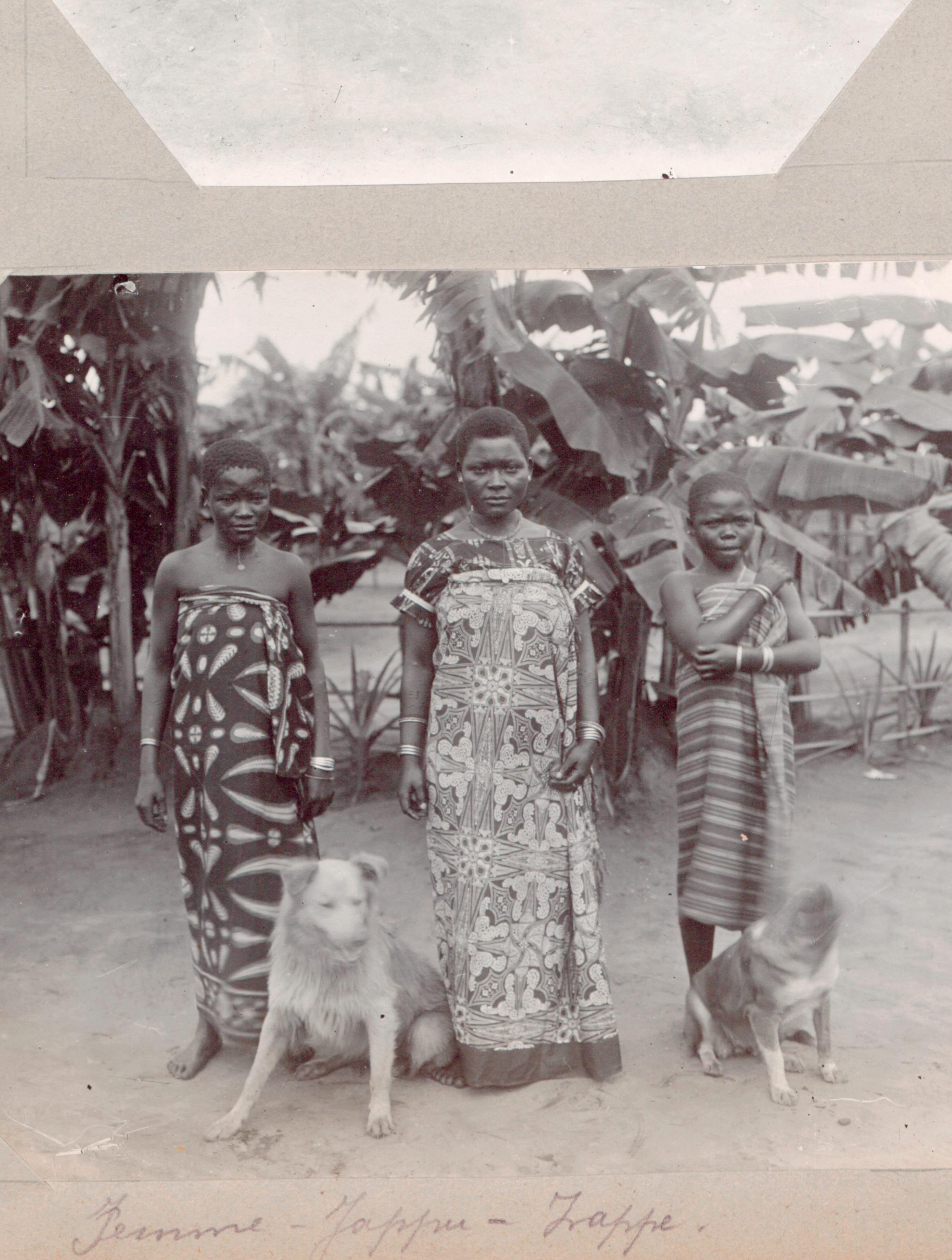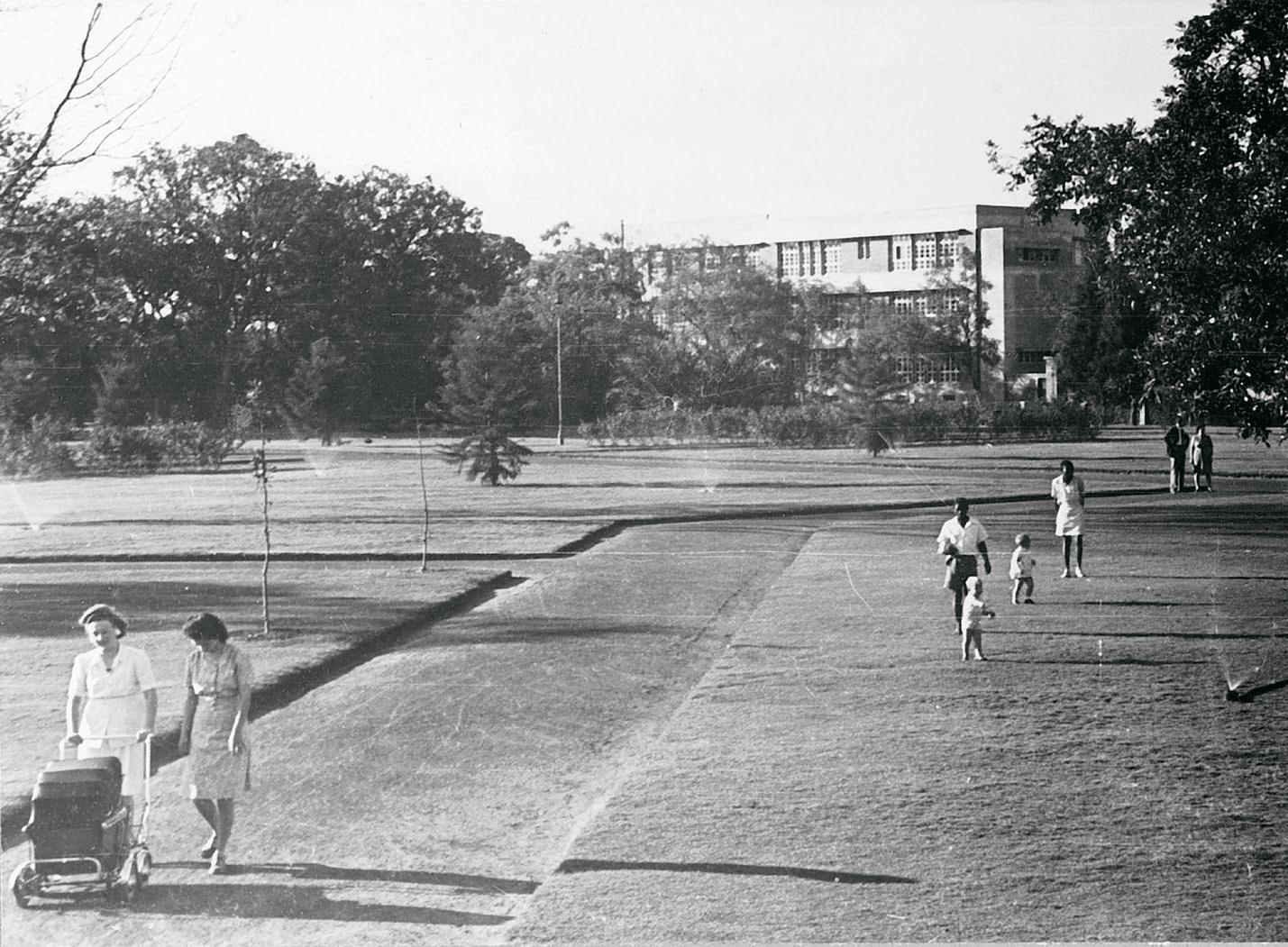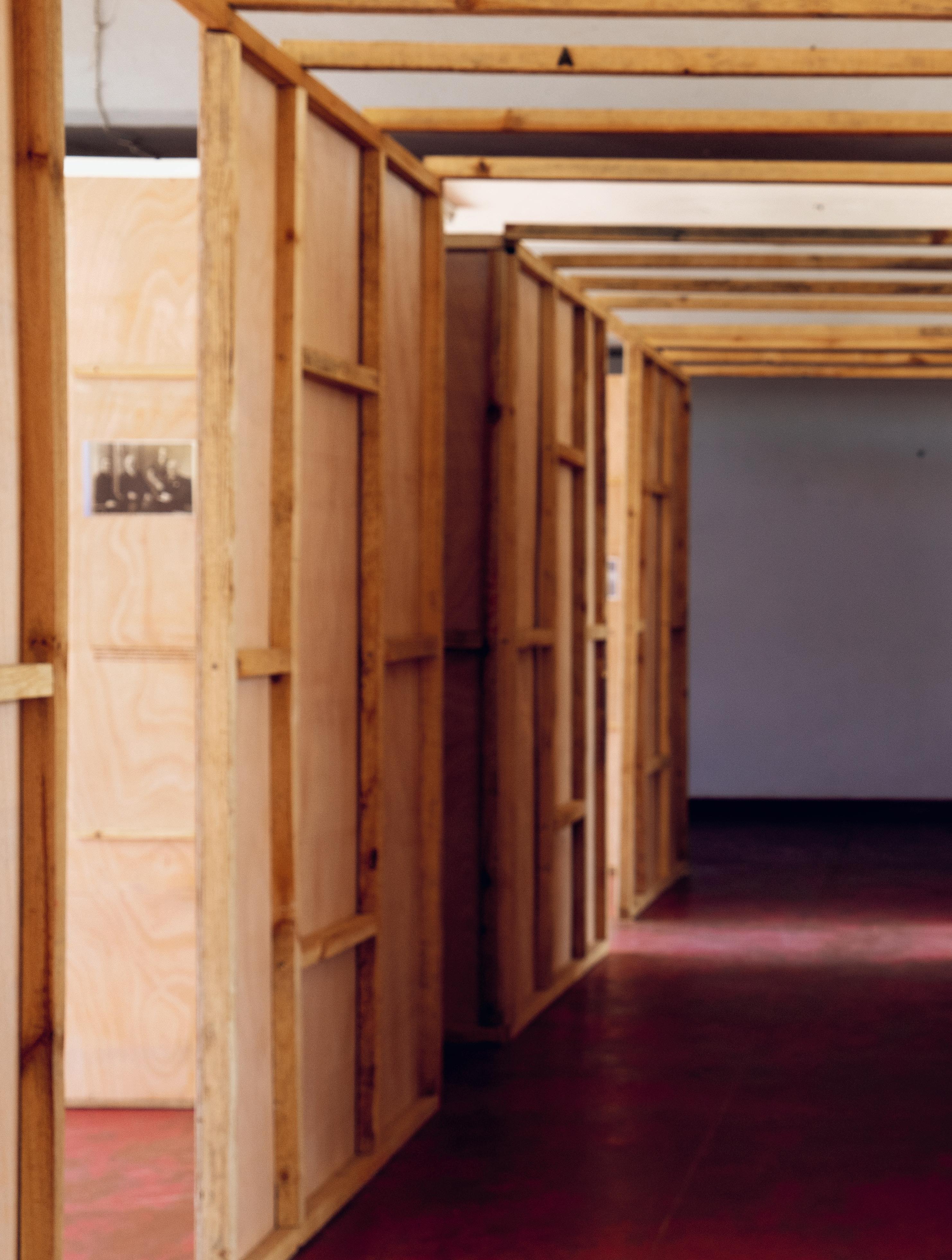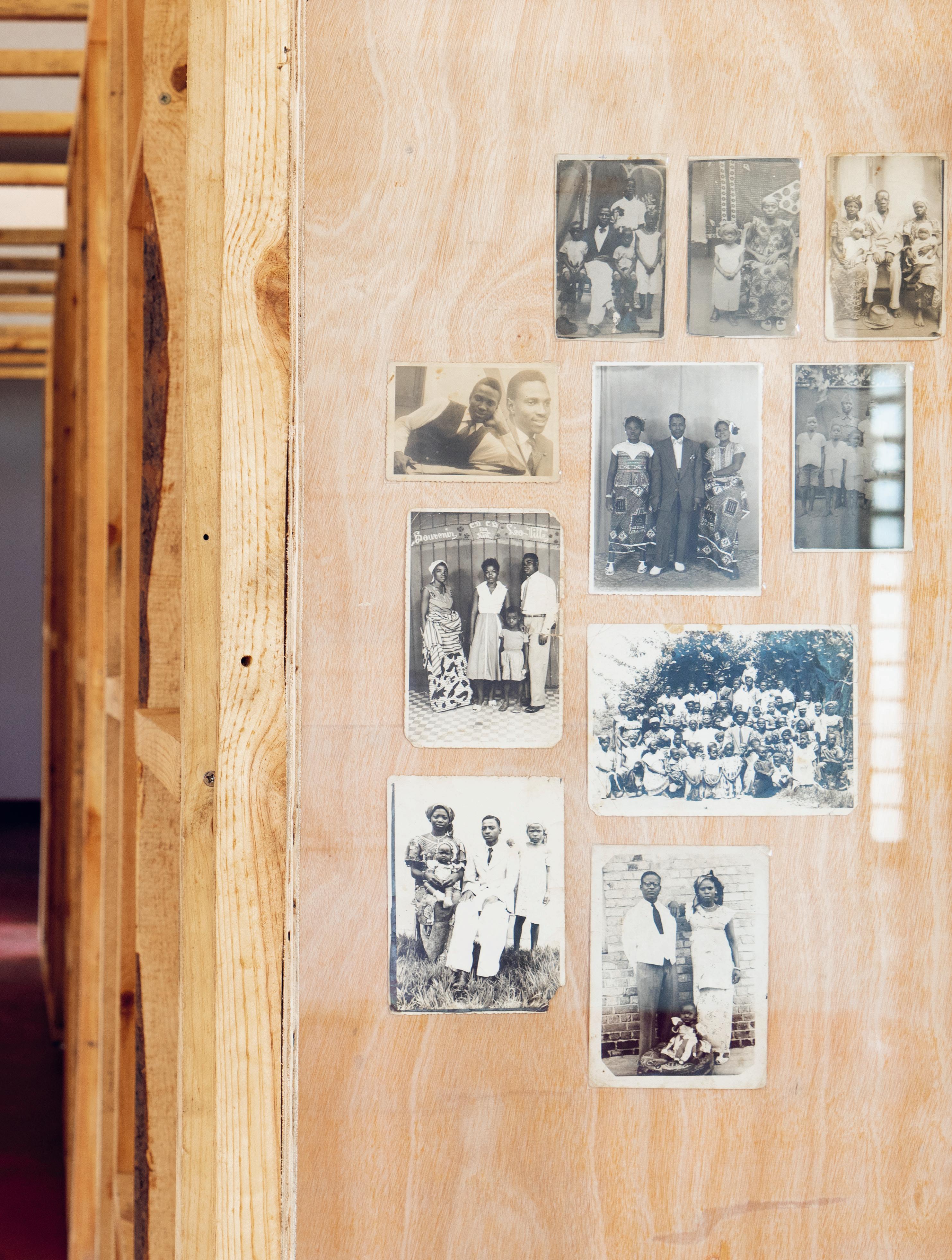
4 minute read
Annie Lulu JASPERS
from Recaptioning Congo
‘the hundred thoroughbreds neighing sunshine amidst the stagnation’
Aimé Césaire, ‘Les pur-sang’, in Les Armes Miraculeuses, 1970
We inhabit an ochre gaze common to the sky and nuisance. Common to the power of the day and to that singular moment when the beechnut of the mother’s almond eyes stretched pointwise to that voracious father and his swallowing stomach. The mother’s abdomen swelled, a helianthus lying on the river. Until the little one was born, crossed with the sun, near the destroyed house. We dogs at the women’s feet have only little right to say anything. What we have seen. Near the collapsed house. We have nothing but the twinkling tinkling of our mistresses’s bracelets, before their children, kept amongst us amidst the mats. To get to know each other, they must have spoken as we all do here, like those who have only vision when the common language is lacking. A secret language. A tongue condemned in advance that will never be uttered, stretched pointwise to this cadmium father and his swallowing stomach. In the village, some people claim that Ceruse came just for Her, for her beauty. But others guessed that he was sick. With heaviness and dampness, with distance and loneliness. The terrible sickness of sadness that can only be consoled with the eyes, through the intensity of an eye. The sickness that can only be consoled with the same language as for us, the dogs at the women’s feet. We know it well, this sickness. Since we share our eyes with men, and even more so with their children.
Unknown, Album page, 1909 -19011
Collection rmca Tervuren, HP.1996.16.1
All rights reserved
Onbekend, Pagina uit album, 1909-1911
Collectie kmma Tervuren, HP.1996.16.1
Alle rechten voor behouden
Inconnu, Page d'album, 1909-1911
Collection mrac Tervuren, HP.1996.16.1
Tous droits réservés


In Koli Jean Bofane Évolué, What’s That?
Without a word or a glance for anyone, Aristide Kashama crossed the courtyard of the plot, opened his door and pulled aside the curtain that hung there. The property was a single-story volume with six doors, housing some single tenants and some single families. He entered, observed by all those present as the day ended in the Renkin district. Soon the sun would set. The inhabitants of Léopoldville1 had deserted the centre,2 having returned to the city and their homes after a hard day’s work. As it fell, the curtain was like a signal. Like Aristide, everyone rushed home before coming out with a stool or a chair that they placed in the middle of the common courtyard. There were Mère Double, the mother of twins; Papa Bopunza, her husband; Séraphine Lupemba, a freewoman; Dieudonné “Petit Makambo,” a washerman in a white man’s house; the dandy Bob Ombale; his fiancée, Élodie, four months pregnant, whom the family had brought to him by force so that he would take responsibility for his actions, as was the custom. There was also Vié Amisi, a widower and office boy at Otraco.3 A bit further on, children were drawing a city in the sand using sticks. When the young man reappeared, he had changed out of his street clothes—black trousers, white shirt, tie, and hat—and was wearing shorts as immaculate as his singlet. Aristide had finished his work. He carried a chair and a gray folder. He sat down as the other tenants looked at him. They were all hanging on his every move.
When he saw that everyone was ready, he took some documents out of the folder and began to read them, whispering to himself. After about a minute of this, Dieudonné Petit Makambo, a rather spirited young man, spoke up:
— Vié, how can you make us wait like this?
— “Patience is the mother of all virtues,” young man. “Everything comes to him who waits.”
— But, with all due respect, Vié, zila zila, mokomboso azanga mokila. 4 Vié, I just want you to continue yesterday’s story.
— Yesterday’s story?
— Yes, about the white man who had noticed that his bottle of whiskey seemed to be emptying itself, suspiciously so.
1 Kinshasa.
2 From 5 p.m. onward the city centre was reserved for Europeans only. A curfew was in place for the Congolese, who had to return to the “Indigenous city.”
3 Office de Transport (fluvial) du Congo.
4 “Waiting and waiting, the gorilla missed the tail.”
H. Philips (Congopresse), Congolese interior in Léopoldville, 1995 Collection rmca Tervuren, HP.1955.17.120
All rights reserved
H. Philips (Congopresse), Congolees Interieur in Leopoldstad, 1955 Collectie kmma Tervuren, HP.1955.17.120 Alle rechten voorbehouden
H. Philips (Congopresse), Intérieur congolais à Léopoldville, 1955 Collection mrac Tervuren, HP.1955.17.120 Tous droits réservés
Unknown, From the private archive of Kanuto Chenge, s.a. All rights reserved

Onbekend, Uit het privéarchief van Kanuto Chenge, s.a. Alle rechten voorbehouden
Inconnu, Archives privées de Kanuto Chenge, s.a. Tous droits réservés en ‘Black girls often worked for Europeans as nannies for their children. They had to be with them everywhere to look after the children. This is the case in this picture: the European women are strolling through a garden while the nannies are minding their children.’ nl ‘Dikwijls werkten zwarte meisjes als kindermeisje bij de Europeanen. Ze moesten overal bij hen zijn om op de kinderen te passen. Dat is het geval op deze foto: de Europese vrouwen wandelen in een tuin en de kindermeisjes passen op de kinderen.’ fr « Souvent, les filles noires travaillaient chez les Européens comme nourrices de leurs enfants. Elles devaient être partout avec eux pour garder les enfants.
Pauline Nyembo, the daughter of an évolué; interview by Maguy Watunia, June 2019.
Pauline Nyembo, dochter van een évolué, geïnterviewd door Maguy Watunia, juni 2019.
C’est le cas sur cette photo : les dames européennes sont en promenade dans un jardin et les nourrices sont en train de surveiller leurs enfants. »
Pauline Nyembo, fille d’un Évolué, interview de Maguy Watunia, juin 2019.
L. Van Bever, A corner of the parc in Élisabethville where mothers and their children come to enjoy the coolness of the late afternoons, 1946.
Collection rmca Tervuren, HP.1956.15.1653, CC-BY 4.0
L. Van Bever, Een deel van het park in Elisabethstad waar moeders met hun kinderen in de late namiddag komen genieten van de koelte, 1946.

Collectie kmma Tervuren, HP.1956.15.1653, CC-BY 4.0
L. Van Bever, Voici un coin du parc d’Élisabethville où mamans et enfants viennent jouir de la fraîcheur des fins d’après-midi, 1946.
Collection mrac Tervuren, HP.1956.15.1653, CC-BY 4.0



